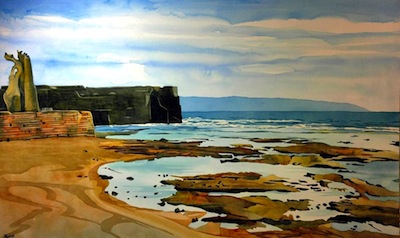Sandy Blass’ solo exhibit No Other Country is at Zack Gallery until Dec. 12. (photo by Olga Livshin)
Artist Sandy Blass’ first solo show in Canada – No Other Country, a series of landscapes – opened last week at Zack Gallery.
Blass has always liked painting, and received her fine arts degree from the University of Calgary in 1984. She worked an office job full-time, raised her family in Calgary and painted as a hobby. Only after her children grew up could she allow herself the joy of following her heart into the arts. Although she still works – part-time at the Jewish Family Service Agency in Vancouver – she now considers herself a full-time artist.
Two important events contributed to her recent emergence as a full-time artist: first, she visited Israel for the first time in 2012; second, she moved to British Columbia in 2014.
Her show’s title, No Other Country, comes from the Hebrew song “I Have No Other Country,” about Israel, although, for Blass, a Jewish Canadian born and raised in Calgary, the sense of belonging is broader. “I belong in both places,” she said in an interview with the Independent, “Canada and Israel.” Her painting “Under the Same Sky,” an abstract play of lines and colors shaped like clouds, feels like the artist’s manifesto, reflecting her love for both countries.
Blass’ discovery of Israel and all things connected to Judaism came late in life. “My parents were Holocaust survivors. We didn’t talk about anything Jewish or about the war,” she explained. “Sometimes, my parents whispered about it but they never talked to me. Our home was secular and full of anxiety. My father always told me not to let anyone know that I was a Jew. Of course, after his concentration camp experience as a young boy, his fear was justified. I never questioned it.”
The older she grew, the more she wanted to learn about her roots and her family history. “I felt that I was missing something,” she said. “My father didn’t want to talk about the past, but my aunt did. She told me some of my family story when I was in my 20s. Later, I started painting with regard to my family history, exploring it through my imagery. I started going to shul. And, finally, I went to Israel.
“The first time – I traveled there in 2012 – I felt like I came full circle. I have family there, those who survived the war in Europe and immigrated to Israel afterwards. Since then, I’ve visited every year. I have even been thinking about aliyah, but not yet. I don’t feel that it is the right time.”

After that first visit, Israel found a permanent place in the artist’s heart and in her paintings. “Since I reconnected with my Jewish identity, I paint both Canadian and Israeli landscapes,” she said. “I traveled to Europe, too, but I never painted there.”
Blass’ bright, vibrant compositions are half real and half abstract, although they are always linked to a particular place. “The sky is always imaginary though,” she said with a smile. “I love painting sky and water. Blue and green are my favorite colors. I love painting reflections, whether in the ocean, a mountain lake, a sea, or just a puddle. This way, water and sky come together, and the best medium to express their coupling is watercolors.”
She paints her landscapes exclusively in watercolor, her favorite medium. “I fell in love with watercolor in high school,” she said. “I love its flow, the transparency of colors. I tried other media over the years – oils and acrylic – but nothing worked for me, while I flourish in watercolors.”
Although watercolor is not the most popular type of paint for professional artists – the majority throughout the centuries has preferred oils – she is in good company. “Watercolors have a respectable place in art history. Joseph Turner, one of the foremost British landscape painters, worked in watercolors,” she said, listing well-known artists who used the same medium she does. “Toni Onley, one of the few Canadian artists represented at the Tate Gallery in London, worked in watercolors. I also want to make inroads into contemporary art in watercolors.”
One of the reasons for her love of watercolor, surprisingly, is that the paintings are not finished when the artist puts down her brush. “I don’t have complete control. The painting is only done when the water stops flowing, dries thoroughly,” she explained. “I experiment with the water flow sometimes. I have a special art table where I paint, and I might change the angle of the surface to affect the water flow. The results could be interesting. Also, the time it takes to dry could be important. Vancouver is more humid than Calgary, so it takes more time for the paintings to dry here. I like the end results better.”
No Other Country continues until Dec 12. To learn more about Blass’ work, visit blassart.com.
Olga Livshin is a Vancouver freelance writer. She can be reached at olgagodim@gmail.com.

